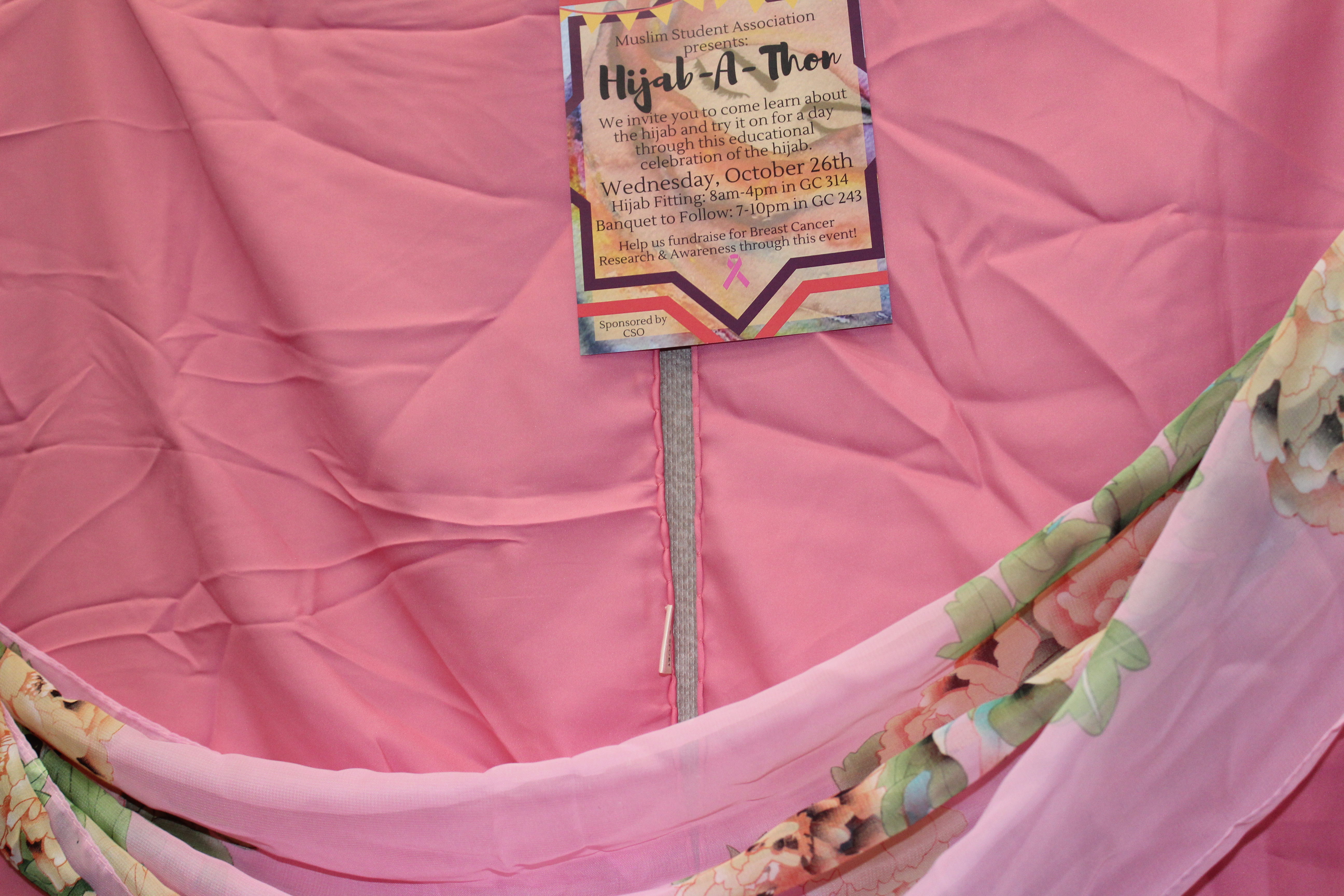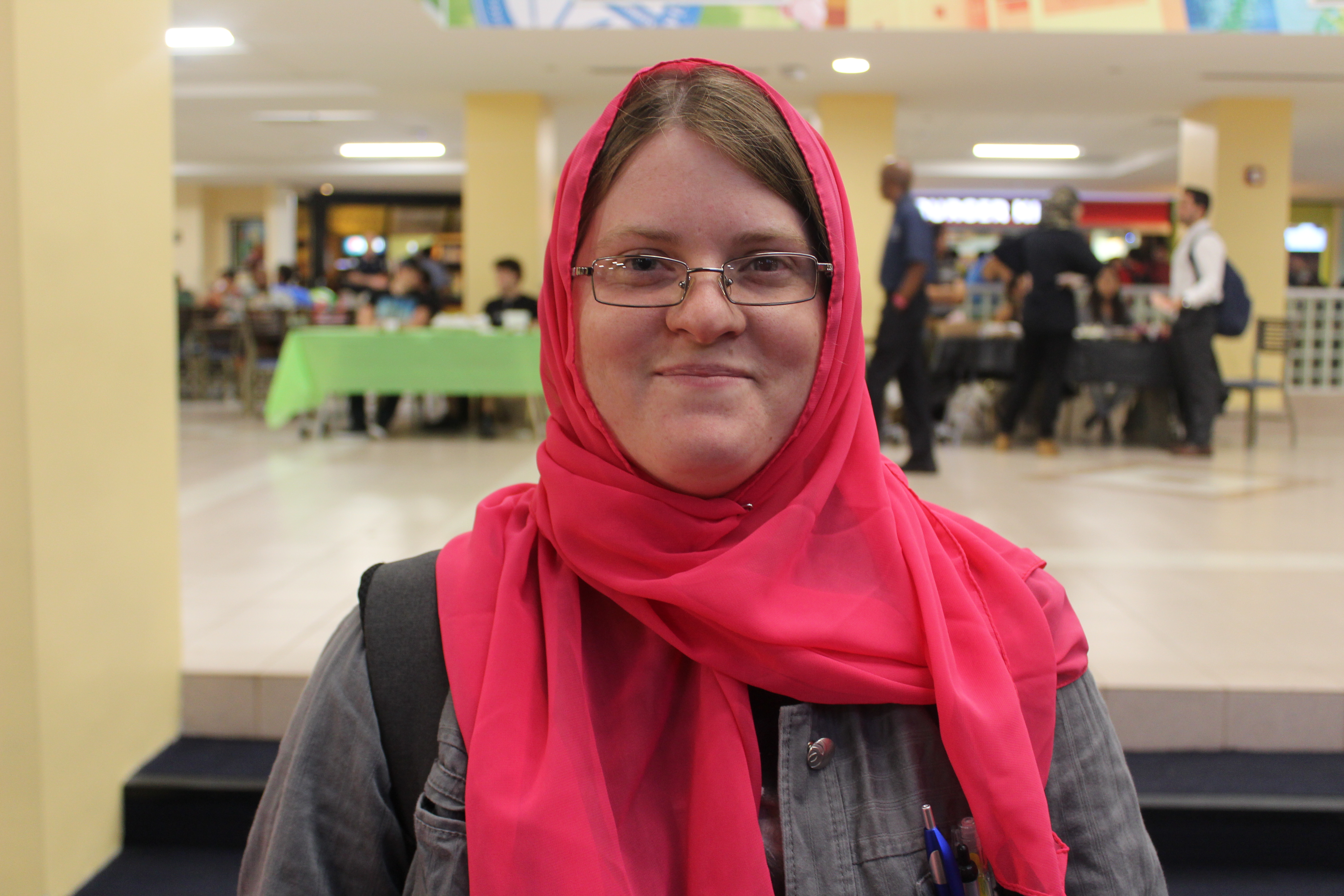- The Muslim Student Association decorate the GC Pit to promote their hijab awareness and breast cancer fundraising event, the Hijab-A-Thon.
- Amna Khanani, a junior psychology major fits Jessica Maldonado, a junior studying biology with a hijab at the MSA’s GC Pit event.
- Jessica Maldonado, junior biology major, smiles in hijab.
- Maria Lopez, a freshman studying biology, receives a Henna tattoo from Aqsa Cheema, event coordinator for the MSA.
- A table of hijab waiting for students to try on at the Muslim Student Association’s GC Pit event promoting the Hijab-A-Thon.
- Members of the Muslim Student Association pose at their GC Pit event promoting the Hijab-A-Thon
Nicole Stone/News Director
For Sara Haroon, the hijab is more than a piece of clothing.
“It represents me,” the president of the MMC Muslim Student Association, said referring to her head scarf. “When I go out, it’s an obvious representation that I’m Muslim and am proud of my faith.”
Every year, the Muslim Student Association extends an invitation to the FIU community – regardless of faith – to dawn the hijab, the veil muslim women wear in public and walk a day in a Muslim woman’s shoes through the Hijab-A-Thon.
The hijab is worn to cover the hair, neck and chest as a symbol of modesty and privacy, but according to Haroon, the hijab is deeply misunderstood.
“[People] think it’s a form of oppression and there’s just a lot of misconceptions,” Haroon said to Student Media.
For this reason, she feels blessed to have grown up in South Florida.
“It’s a very diverse community, so I don’t get too much racism wearing it.”
But her upbringing has not erased her awareness of the stigma surrounding hijab, even in a city as diverse as Miami.
“A lot of my friends who wear hijab get racist comments yelled at them such as ‘go back to your country.’ Even here, which shocks me in Miami, it is still common.”
She feels that the remarks stem from a place of misunderstanding and unfamiliarity with Islamic culture.
“People don’t know what Islam or Muslims are,” Haroon said. “So we get labelled as extremists.”
Haroon has been wearing hijab for seven years. She says that after so long, she isn’t bothered by any staring she may experience.
“People do look at me, they’ll maybe stare a little longer or do a double take, but honestly, I don’t notice it anymore.” Haroon said.
To Haroon, wearing the hijab actually inclines people to focus more on her words than her appearance.
“A lot of women get degraded, this takes away that feeling of being viewed as a piece of meat. I personally feel that I don’t get judged by my appearance, I get judged by what I’m saying to you” Haroon explained.
Hijab is a way of life for Muslim women.
“It changes a lot how you act. I used to actually be super shy, then, I started wearing hijab and it has actually made me more outgoing,” Haroon said. “It’s interesting because people would think it’d be the opposite. It’s become a part of myself and my character.”
Over time, the hijab has evolved into a form of expression and fashion.
“We do what God tells us to do, but we don’t need to be boring. We can be expressive.”
Haroon compared the way people can be expressive with their hairstyle to a hijabi’s expression in her hijab style.
“Actually, my shirt says ‘Legit Hijabi,’” Haroon said, pointing at her shirt. “Because it’s become such a fashion trend”
This year, the hijab has made a historical debut in NY fashion week. Muslim fashion designer, Anniesa Hasibuan, featured the hijab in every outfit. Hasibuan found inspiration in the vibrancy of her home, Jakarta according to her instagram.
As the hijab begins to find its way in mainstream culture, it’s rise in the mainstream is not to be mistaken with a one-day fashion decision, according to Haroon.
“You have to do it properly,” she explained. “If you’re wearing it, I would like that you’re wearing it by being aware of what it is first. If you’re wearing it for fun, I wouldn’t appreciate that. If you know the value behind it, the reason muslim women wear it, wear it with respect and wear it for understanding, you’re not just wearing it for a fashion statement, or pretending you’re Muslim on halloween.”
Haroon says that the Hijab-A-Thon is the perfect way to experience the hijab.
“People say they would like to do it, but are afraid of offending us. This is the perfect environment to do it because we’ll teach you what it is. You’ll learn from a Muslim, from the source.” she said.
The Hijab-A-Thon is an all day event, taking place Oct. 26. Participants will be fit with a hijab from 8 a.m. to 4 p.m. in GC 343, afterwhich, they will proceed with their normal routine. At 7:30 p.m., all participants will meet for the Hijab-A-Thon Banquet in GC 243, where they will have the chance to share their experiences throughout the day and raise funds for breast cancer awareness and research.
Haroon feels that there is a sense of womanhood in the hijab, so raising funds for breast cancer is only natural.
“We didn’t just want it to be about us,” Haroon said. “It’s great to teach about Islam, but we should do more and give back in a sense.”
In past years the banquet has yielded some memorable statements from participants for Haroon.
“At the banquet, when people tell us the experiences they had, they say things like ‘we felt we were representing something’ and ‘i’m representing this faith. I’m not just me anymore, i’m identified and attached to this faith.’” Haroon recounted.
For some Muslim women, such as Haroon, the hijab holds its power in its outwardness.
“A lot of religious practices are internal. But [the hijab] is a commandment from God that is shown to the whole world,” Haroon said. “Everyone sees that I took this commitment. I think that’s what’s really cool and different about it. It’s an act of worship that’s public and always with you wherever you go.”
The Hijab-A-Thon provides the experience of a deeply rooted part of Islamic culture and the realization of a Muslim woman’s reality.
“I’d love to emphasize that it’s a great experience and I love when people ask me about hijab and my religion, I really appreciate it. And [participants] all love the experience too. Hijab-a-thon is my favorite event.” Haroon said.
Students interested in participating can reserve a hijab on the MSA’s facebook page.












Some women in the United States may willingly wear hijabs. However, hijabs are a symbol of oppression to many because of multiple nations that force, under criminal penalty, this garment on women who do not want to wear it. In many places where it is not enforced by law, it is enforced by family and community coercion.
Hijab-wearers in America enjoy the legal right to wear what they want. It is hard to understand why they need an activist movement over a non-issue. It is also hard to understand why they don’t take a stand against forced hijab worldwide.